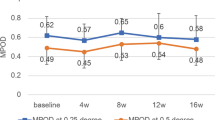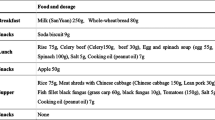Abstract
Purpose A review of the role of vitamins, minerals, carotenoids and essential fatty acids in relation to eye health. The mode of action may be directly on the eye or by promoting bodily health on which the eye depends.
Results The lens and retina suffer oxidative damage and the anti-oxidant vitamins A, C and E are implicated as protective. Studies in man give indifferent support to the role of nutrition in the development of cataract. In the elderly, vitamin intake may be inadequate, so that a vitamin supplement may be reasonable. Zinc has a role in retinal metabolism and may be beneficial in macular degeneration. Selenium has an anti-oxidant role. Other minerals including copper have a less defined role. Carotenoids are concentrated at the macula and have an anti-oxidant role. A reduced risk, of macular degeneration is found in relation to a high serum level. The essential fatty acid, gamma-linolenic acid (GLA), is useful in Sjogren's syndrome and may help in other dry eye conditions. Omega-3 fatty acids are important in retinal development and have a role in preventing cardiovascular disease.
Conclusion All persons should be encouraged to maintain healthy nutrition. Middle-aged and elderly patients may benefit from a supplement. An intake in excess of the recommended daily intake may be beneficial, but this is not proven. Further clinical trials are indicated to define the advisability of vitamin, mineral and other supplements. Dosages for recommended intake and for supplements are given.
Similar content being viewed by others
Article PDF
References
Taylor A, Jaques PF, Nadler D, et al. Relationship in humans between ascorbic acid consumption and levels of total and reduced ascorbic acid in lens, aqueous humour, and plasma. Curr Eye Res 1991;10:751–9.
Chen TT, Hockwin O, Dobbs R, Knowles W, Eckerskorn U . Cataract and health status: a case control study. Ophthalmic Res 1988;20:1–9.
Klein BEK, Klein R, Jensen SC, Linton KLP . Hypertension and lens opacities from the Beaver Dam Eye Study. Am J Ophthalmol 1995;119:640–6.
Harding JJ, van Heyningen R . Epidemiology and risk factors for cataract. Eye 1987;1:537–41.
Benson WH, Farber ME, Caplan RJ . Increased mortality rates after cataract surgery. Ophthalmology 1988;95:1288–92.
Oliver MF . Antioxidant nutrients, atherosclerosis, and coronary heart disease [editorial]. Br Heart J 1995;73:299–301.
Brown NAP, Bron AJ . Lens disorders: a clinical manual of cataract diagnosis. Oxford: Butterworth-Heinemann, 1996:108–9.
Harding JJ, Crabbe MJC . The lens: development, proteins, metabolism and cataract. In: Davson H, editor. The eye, vol IB. London: Academic Press, 1984:chap 3.
Costagliola C, Iuliano G, Menzione M, Rinaldi E, Vito P, Auricchio G . Effect of vitamin E on glutathione content in red blood cells, aqueous humour and lens of humans and other species. Exp Eye Res 1986;43:905–14.
Stephens RJ, Negi DS, Short SM, van Kuijk FJGM, Dratz EA, Thomas DW . Vitamin E distribution in ocular tissues following long-term dietary depletion and supplementation as determined by microdissection and gas chromatography-mass spectrometry. Exp Eye Res 1988;47:237–45.
Sarma U, Brunner E, Evans J, Wormald R . Nutrition and the epidemiology of cataract and age related maculopathy. Eur J Clin Nutr 1994;48:1–8.
Linklater HA, Dzialoszynski T, McLeod HL, Sandford SE, Trevithick JR . Modelling cortical cataractogenesis. XL Vitamin C reduces gamma-crystallin leakage from lenses in diabetic rats. Exp Eye Res 1990;51:241–7.
Malik A, Kojima M, Sasaki K . Morphological and biochemical changes in lenses of guinea pigs after vitamin-C deficient diet and UV-B radiation. Ophthalmic Res 1995;27:189–96.
Tsao CS, Xu LF, Young M . Effect of dietary ascorbic acid on heat-induced eye lens protein damage in guinea pigs. Ophthalmic Res 1990;22:106–10.
Khan HA, Leibowitz HM, Ganley JP, Kinni MM, Colton T, Nickerson RS, Dawber TR . The Framingham Eye Study. 1. Outline and major prevalence findings. Am J Ophthalmol 1977;106:17–32.
Chatterjee A, Milton RC, Thyle S . Prevalence and aetiology of cataract in Punjab. Br J Ophthalmol 1982;66:35–42.
Jaques PF, Chylack LT . Epidemiologic evidence of a role for the antioxidant vitamins and carotenoids in cataract prevention. Am J Clin Nutr 1991;53 (Suppl 1):S352–5.
Liu IY, Whiye L, LaCroix AZ . The association of age-related macular degeneration and lens opacities in the aged. Am J Public Health 1989;79:765–9.
Leske MC, Chylack LT Jr, Wu S-Y . The lens opacities case-control study: risk factors for cataract. Arch Ophthalmol 1991;109:244–51.
Robertson JMcD, Dormer AP, Trevithick JR . Vitamin E intake and risk of cataracts in humans. Ann NY Acad Sci 1989;570:372–82.
Leske MC, Wu S-Y, Hyman L, Sperduto R, Chylack LT, Milton RC, et al. Biochemical factors in the lens opacities. Case Control Study Group. Arch Ophthalmol 1995;113:1113–9.
Hankinson SE, Stampfer MJ, Seddon JM, Colditz GA, Rosner B, Speizer FE, Willett WC . Nutrient intake and cataract extraction in women: a prospective study. BMJ 1992;305:335–9.
Vitale S, West S, Hallfrisch J, Alstob C, Wang F, Moorman C, et al. Plasma antioxidant and risk of cortical and nuclear cataract. Epidemiology 1993;4:195–203.
Seddon JM, Christen WG, Manson JE, LaMotte FS, Glynn RJ, Buring JE, Hennekens CH . The use of vitamin supplements and the risk of cataract among US male physicians. Am J Public Health 1994;84:788–92.
Mares-Perlman JA, Klein BE, Klein R, Ritter LL . Relation between lens opacities and vitamin and mineral supplement use. Ophthalmology 1994;101:315–25.
Knekt P, Heliovaara M, Rissanan A, Aroma A, Aaran R-K . Serum antioxidant vitamins and risk of cataract. BMJ 1992;305:1392–4.
Libondi T, Costagliola C, Delia Corte M, et al. Cataract risk factors: blood level of antioxidative vitamins, reduced glutathione and malondialdehyde in cataractous patients. Metab Pediatr Syst Ophthalmol 1991;14:31–6.
Maraini G, Pasquini P, Sperduto RD . Risk factors for age-related cortical, nuclear, and posterior subcapsular cataracts. Am J Epidemiol 1991;133:541–53.
Mares-Perlman JA, Brady WE, Klein BE, Palta M, Bowen P, Stacewicz-Sapuntzakis M . Serum carotenoids and tocopherols and severity of nuclear and cortical opacities. Invest Ophthalmol Vis Sci 1995;36:276–88.
Mohan M, Sperduto RD, et al. India-US case-control study of age related cataract. Arch Ophthalmol 1989;107:670–6.
Gerster H . Antioxidant vitamins in cataract prevention. Z Ernahrungswis 1989;28:56–75.
Sperduto RD, Hu T-S, Milton RC, Zhao JL, Everett DF, Cheng QF, et al. The Linxian Cataract Studies: two nutrition intervention trials. Arch Ophthalmol 1993;111:1246–53.
Seddon JM, Ajami UA, et al. Dietary carotenoids, vitamins A, C and E and advanced age-related macular degeneration. JAMA 1994;272:1413–20.
Tso MOM, Woodford BJ, Lank KW . Distribution of ascorbate in normal primate retina and after photic injury: a biochemical, morphological correlated study. Curr Eye Res 1984;3:166–74.
Organisciak DT, Wang H, Li ZY, Tso MOM . The protective effect of ascorbate in retinal light damage of rats. Invest Ophthalmol Vis Sci 1985;26:1580–8.
Hayes KC . Retinal degeneration in monkeys induced by deficiencies of vitamin E or A. Invest Ophthalmol 1974;13:499–510.
Goldberg J, Flowerdew G, Smith E, Brody JA, Tso MO . Factors associated with age-related macular degeneration: an analysis of data from the first National Health and Nutrition Examination Survey. Am J Epidemiol 1988;128:700–11.
West S, Vitale S, Hallfrisch J, Munoz B, Muller D, Bressler S, Bressler NM . Are anti-oxidant supplements protective for age-related macular degeneration? Arch Ophthalmol 1994;112:222–7.
Sanders TA, Haines AO, Wormald R, Wright LA, Obeid O . Essential fatty acids, plasma cholesterol, and fat-soluble vitamins in subjects with age-related maculopathy and matched control subjects. Am J Clin Nutr 1993;57:428–33.
Mares-Perlman JA, Brady WE, Klein R, Klein BEK, Bowen P, Stacewicz-Sapuntzakis M, Palta M . Serum antioxidants and age-related macular degeneration in a population-based case-control study. Arch Ophthalmol 1995;113:1518–23.
The Eye Diseases Case Control Study Group. Biochemical antioxidant status and neovascular age-related macular degeneration. Arch Ophthalmol 1993;111:104–9.
Hoyt CS . Vitamin metabolism and therapy in ophthalmology. Surv Ophthalmol 1979;24:177–90.
Rothman KJ, Moore LL, Singer MR, Nguyen U-STD, Manino S, Milunsky A . Teratogenicity of high vitamin A intake. N Engl J Med 1995;333:1369–73.
Meydani SN, Meydani M, Rall LC, Morrow F, Blumberg JB . Assessment of the safety of high-dose, short term supplementation with vitamin E in healthy older adults. Am J Clin Nutr 1994;60:704–9.
Blumberg J . Are antioxidants at an awkward age? J Am Col Nutr 1994;13:218–9.
Karcioglu ZA . Zinc in the eye. Surv Ophthalmol 1982;27:114–22.
Newsome DA, Oliver PD, Deupree DM, Miceli VM, Diamond JG . Zinc uptake by primate retinal pigment epithelium and choroid. Curr Eye Res 1992;11:213–7.
Solomons NW, Russell RM . The interaction of vitamin A and zinc: implications for human nutrition. Am J Clin Nutr 1980;33:2031–104.
Newsome DA, Swartz M, Leone NC, Elston RC, Miller E . Oral zinc in macular degeneration. Arch Ophthalmol 1988;106:192–8.
Bhat KS . Plasma calcium and trace metals in human subjects with mature cataract. Nutr Rep Int 1988;37:157–63.
Barash H, Poston HA, Rumsey GL . Differentiation of soluble proteins in cataracts caused by deficiencies of methionine, riboflavin or zinc diets fed to Atlantic salmon, Salmo salar, rainbow trout, Salmo gairdneri, and lake trout, Salvelinus namaycush. Cornell Vet 1982;72:361–71.
Dietary reference values for food energy and nutrients for the UK. HMSO Dept of Health Report 41. 1991.
Schalch W . Carotenoids in the retina: a review of their possible role in preventing or limiting damage caused by light and oxygen. In: Emerit I, Chase B, editors. Free radicals and ageing. Basel: Birkhauser, 1992.
Jaques PF, Chylack LT, McGandy RB, Hartz SC . Antioxidant status in persons with and without senile cataract. Arch Ophthalmol 1988;106:337–40.
Horrobin DF . Essential fatty acid metabolism in disease of connective tissue with special reference to scleroderma and to Sjögren's syndrome. Med Hypotheses 1984;14:233–47.
Uauy-Dagach R, Mena P . Nutritional role of omega-3 fatty acids during the perinatal period. Clin Perinatol 1995;22:157–75.
Birch E, Birch D, Hoffman D, Hale L, Everett M, Uauy R . Breast-feeding and optimal visual development. J Pediatr Ophthalmol Strabismus 1993;30:33–8.
Gordon WC, Bazan NG . Docosahexaenoic acid utilisation during rod photoreceptor cell renewal. J Neurosci 1990;10:2190–202.
Gordon WC, Rodriguez de Turco EB, Bazan NG . Retinal pigment epithelial cells play a central role in the conservation of docosahexaenoic acid by receptor cells after shedding and phagocytosis. Curr Eye Res 1992;11:73–83.
Fischer S, Vischer A, Preac-Mursic V, Weber PC . Dietary docosahexaenoic acid is retroconverted in man to eicosapentaenoic acid, which can be quickly transformed to prostaglandin 13. Prostaglandins 1987;34:367–75.
Ascherio A, Rimm EB, Stampfer MJ, Giovannucci EL, Willett WC . Dietary intake of marine n-3 fatty acids, fish intake, and the risk of coronary heart disease among men. N Engl J Med 1995;332:977–82.
Siscovick DS, Raghunathan TE, King I, et at. Dietary intake and cell membrane levels of long chain n-3 polyunsaturated fatty acids and the risk of primary cardiact arrest. JAMA 1995;274:1363–7.
Recommended Dietary Allowances, 10th ed. Subcommittee on the 10th edition of the RDAs, Food and Nutrition Board, Commission of Life Sciences, National Research Committee, 1989.
Author information
Authors and Affiliations
Rights and permissions
About this article
Cite this article
Brown, N., Bron, A., Harding, J. et al. Nutrition supplements and the eye. Eye 12, 127–133 (1998). https://doi.org/10.1038/eye.1998.21
Issue Date:
DOI: https://doi.org/10.1038/eye.1998.21
Keywords
This article is cited by
-
Zinc status in public health: exploring emerging research trends through bibliometric analysis of the historical context from 1978 to 2022
Environmental Science and Pollution Research (2023)
-
Inner Blood-Retinal Barrier Transporters: Role of Retinal Drug Delivery
Pharmaceutical Research (2009)
-
Nutrient intake in women with primary and secondary Sjögren's syndrome
European Journal of Clinical Nutrition (2003)
-
Hereditäre Makulaerkrankungen — Aktueller Stand der Therapiemöglichkeiten
Spektrum der Augenheilkunde (2003)



